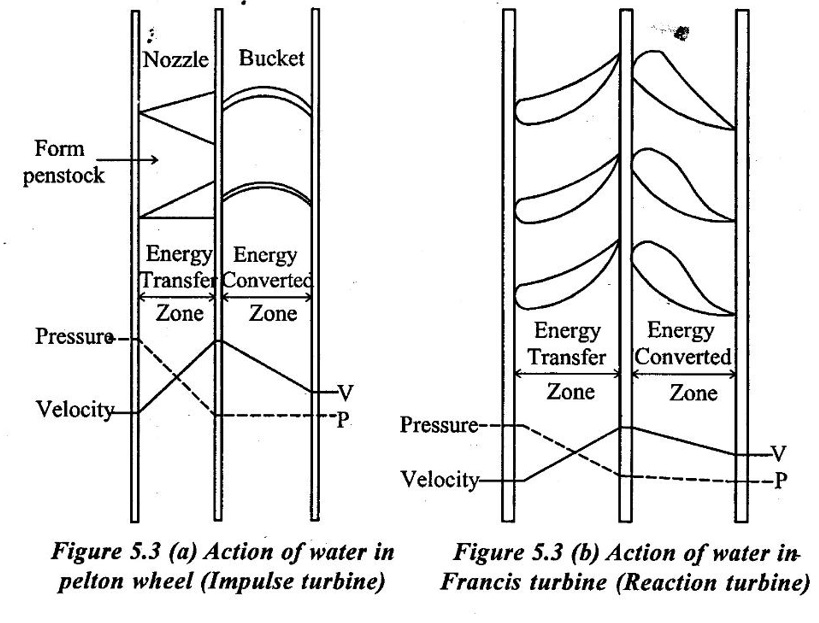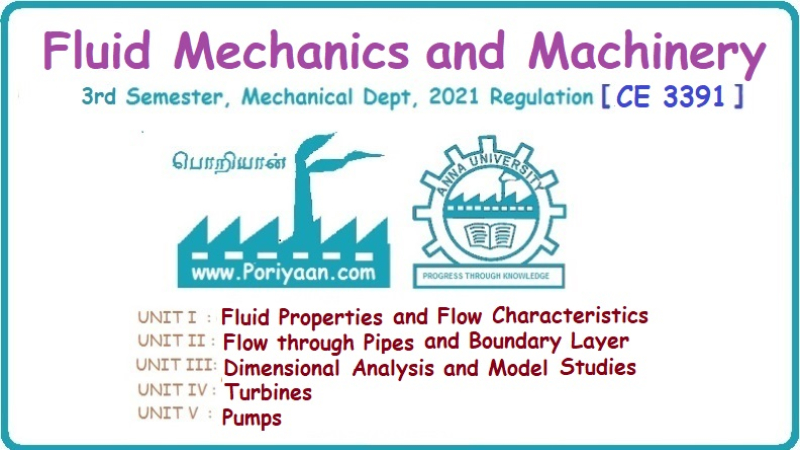Fluid Mechanics and Machinery: Unit 4: Turbines
Classification of Hydraulic Turbines
The hydraulic turbines are classified based on different criteria like the nature of flow of energy available at turbine inlet, the head, quantity of water available, the direction of flow of water in the runner, the specific speed of the turbine, the disposition of the turbine shaft and the name of the originator.
CLASSIFICATION OF HYDRAULIC TURBINES The hydraulic turbines are classified based on different criteria like the nature of flow of energy available at turbine inlet, the head, quantity of water available, the direction of flow of water in the runner, the specific speed of the turbine, the disposition of the turbine shaft and the name of the originator. (a) Impulse turbine (b) Reaction turbine. (a) Impulse turbine In an impulse turbine, the whole pressure energy of the water possesses is converted into kinetic energy before water is passed on the turbine wheel through the nozzle. The water comes out of the nozzle in the form of a jet with very high velocity. The direction of jet is changed by buckets. It requires high head and low discharge at the inlet of the turbine. The pressure of water is atmospheric and remains constant while passing over the runner. Examples - Pelton wheel turbine. (b) Reaction turbine In an reaction turbine, the water supplied to the reaction turbine possess both pressure as well as kinetic energies. Unlike the impulse turbine whole of the pressure energy of water not completely converted into kinetic energy. In these turbines, a part of pressure energy is first converted into kinetic energy before supplied to runner and remain converted while passing over the runner. Hence these turbine work on the principle of impulse reaction. The runner of this turbines being under pressure above the atmosphere. It requires the blades of turbine to run inclosed passage (or) casing which are completely filled with water in all working conditions. Examples: Francis turbine, kaplan turbine, propeller turbine etc, The Reaction turbine is also known as Pressure turbine. (a) High head and low quantity turbine H > 250 m. Example - pelton wheel turbine. (b) Medium head and medium quantity turbine 60 m < H < 250 m Example -Francis turbine (c) Low head and high quantity turbine H < 60 m Example - Kaplan turbine (a) Axial flow turbine In this type of turbine, the water enters and leaves parallel to the axis of the runner shaft. Example: kaplan and propeller turbines. (b) Radial flow turbine In this type of turbine, the path of water flow in the radial direction and in a plane normal to the runner shaft. The radial flow turbines are of two types, one is inward radial flow turbine and another one is outward radial flow turbine. If the water flows from outwards to inward radially to centre of runner, it is called inward flow radial turbine. If the water flow is from inward to outward radially to centre of runner, it is called outward flow radial turbine. Practically no such type of radial flow turbines are used. Example: Foutnyeton and old francis turbine. (c) Tangential flow turbine In this type of turbines the flow takes place tangential to the circumference of enclosing the runner. Example - pelton wheel turbine. (d) Mixed flow turbines In this type of turbines the water enters to the runner radially and leaves parallel to the axis of the runner shaft. Example: Modern francis turbine, Detiaz turbines (a) Low specific speed Example: pelton wheel turbine single jet 8.5 to 30 pelton wheel turbine double jet 8.5 to 51 (b) Medium specific speed Example: Francis turbine 51 to 255 (c) High specific speed Example: kaplan and propeller turbine 255 to 860 (a) Vertical shaft turbine Example: Francis, propeller and kaplan turbines (b) Horizontal shaft turbine Example: Pelton wheel turbine (a) Pelton wheel turbine (b) Francis turbine (c) Kaplan turbine(1) Based on Nature of flow of energy available at turbine inlet

(2) Based on Head and quantity of water available.
(3) Based on the direction of flow through the runner.
(4) Based on specific speed
(5) Based on disposition of the turbine shaft
(6) Based on the name of the originator
Fluid Mechanics and Machinery: Unit 4: Turbines : Tag: : - Classification of Hydraulic Turbines
Related Topics
Related Subjects
Fluid Mechanics and Machinery
CE3391 3rd semester Mechanical Dept | 2021 Regulation | 3rd Semester Mechanical Dept 2021 Regulation
